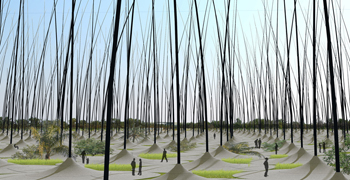 NEW YORK — Wind power has become a force in the energy market and continues to grow as a share of the industry, with 83 countries using it as part of their energy portfolio by 2011. Wind energy represented 2.5 percent of the world’s energy output in 2010, a number that has increased by at least 25 percent per year for over a decade. Wind turbines have mostly dominated the industry up to this point, but several shortcomings in that technology have led designers to seek out the next big thing in wind tech. Wind turbines have been known to cause problems for specific species of birds and bats, can be extremely noisy, and are often difficult to place in the most ideal locations to capture the maximum amount of energy.
NEW YORK — Wind power has become a force in the energy market and continues to grow as a share of the industry, with 83 countries using it as part of their energy portfolio by 2011. Wind energy represented 2.5 percent of the world’s energy output in 2010, a number that has increased by at least 25 percent per year for over a decade. Wind turbines have mostly dominated the industry up to this point, but several shortcomings in that technology have led designers to seek out the next big thing in wind tech. Wind turbines have been known to cause problems for specific species of birds and bats, can be extremely noisy, and are often difficult to place in the most ideal locations to capture the maximum amount of energy.
These issues have led some designers to start looking way outside the box, seeking inspiration from nature or other industries to better harvest the power of the wind.
New York design firm Atelier DNA looked to the plant world for inspiration in designing its Windstalk technology, which garnered a second place finish in the flagship version of the Land Art Generator competition in 2010. The Land Art Generator Initiative was started by the Society for Cultural Exchange, a Pittsburgh-based non-profit that strives to spread the influence of cutting edge art design and renewable energy. The initiative challenges innovators to create large-scale green energy solutions.
While wind turbines are known for driving people away with loud noise and disrupting previously beautiful scenery, the windstalk concept was designed to be less obtrusive and more aesthetically pleasing. The structures resemble giant waves of wheat swaying in the wind, with light emitting diodes illuminating the tops of each stalk when energy is being produced.
“Windstalk is completely silent, and the image associated with them is something we’re already used to seeing in a field of wheat or reeds in a marsh. Our hope is that people living close to them will like to walk through the field — especially at night — under their own, private sky of swarming stars,” Atelier DNA founding partner Dario Nunez-Ameni commented to Discovery News.
The windstalks are 180-feet-tall flexible structures that resemble cattail plants or individual stalks of wheat. The design entry consisted of 1,203 individual “stalks,” arranged in an elliptical half-moon shape, covering 280,000 square feet. Each stalk sits on a concrete base ranging from 33 to 66-feet in diameter. Carbon-fiber stalks rise out of the concrete, shrinking from a foot in width at the bottom to 2 inches at the tip. Electrodes and ceramic disks within the stalks create electricity when they bend in the wind. The installation would produce electricity at very close to the same rate as a typical wind turbine grouping covering the same area.
“Our system is very efficient in that there is no friction loss associated with more mechanical systems such as conventional wind turbines,” explained Nunez-Ameni.
The bases of each stalk are designed uniquely, with their combined effects funneling rainwater into specific areas to feed patches of plant life, forming an interesting, park-of-the-future look. The area under the stalks would be safe for humans, creating accessible quasi-green space. The system would also collect water and store it in an underground chamber, allowing it to fall through a wind turbine into a lower chamber to create energy on days where the wind doesn’t hold up its part of the bargain.
In the long run, Nunez-Ameni said the Windstalk technology would be more efficient than turbines, as individual stalks could be placed much closer together than turbine towers. Turbines interfere with each other if placed too close together, because they create air turbulence that interferes with fellow turbines’ abilities to collect energy. The Windstalk design avoids this problem, as they feed off of chaos and turbulence. The more wind running in random directions in a Windstalk farm, the better, as stalks harvest energy no matter what angle the wind hits them from.
The technology has even bred an offshoot project, called Wavestalk, where the company is exploring the possibility of carrying out a similar idea underwater to harness energy from ocean currents.

